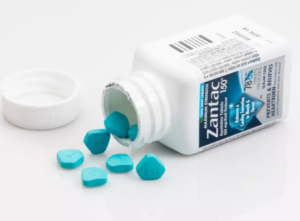The U.S. Food and Drug Administration has requested all manufacturers withdraw all Zantac and ranitidine, both prescription and over-the-counter (OTC) , from the market immediately. This is the latest step in an ongoing investigation of a contaminant known as N-Nitrosodimethylamine (NDMA) in ranitidine medications (commonly known by the brand name Zantac).
According to the request, “the agency has determined that the impurity in some ranitidine products increases over time and when stored at higher than room temperatures and may result in consumer exposure to unacceptable levels of this impurity. As a result of this immediate market withdrawal request, ranitidine products will not be available for new or existing prescriptions or OTC use in the U.S.”

However, private testing has shown the problem to be more more serious and extensive than the FDA is letting on, and the levels of NDMA exposure appear to be much higher than the FDA is admitting.
Online pharmacy, Valisure discovered the link of Zantac and its generics to the carcinogen NDMA during its routine testing of every batch of every medication, and first notified the FDA of its initial findings in June of 2019. On September 13th, 2019 Valisure filed a detailed petition with the Food and Drug Administration asking the agency to recall all products containing ranitidine. Valisure’s research, along with that of Stanford University and others, found that NDMA was the result of the “inherent instability” of the ranitidine molecule. This means that all manufacturers, brand or generic, and all lots of ranitidine-containing medications are affected and could generate very high levels of NDMA in the human body upon ingestion.
“There’s no acceptable cancer risk for a drug like this,” stated David Light, CEO of Valisure regarding the impurities in these products.
According to a statement provided by the FDA, “NDMA is a probable human carcinogen (a substance that could cause cancer). In the summer of 2019, the FDA became aware of independent laboratory testing that found NDMA in ranitidine. Low levels of NDMA are commonly ingested in the diet, for example NDMA is present in foods and in water. These low levels would not be expected to lead to an increase in the risk of cancer. However, sustained higher levels of exposure may increase the risk of cancer in humans. The FDA conducted thorough laboratory tests and found NDMA in ranitidine at low levels. At the time, the agency did not have enough scientific evidence to recommend whether individuals should continue or stop taking ranitidine medicines, and continued its investigation and warned the public in September 2019 of the potential risks and to consider alternative OTC and prescription treatments.”
“New FDA testing and evaluation prompted by information from third-party laboratories confirmed that NDMA levels increase in ranitidine even under normal storage conditions, and NDMA has been found to increase significantly in samples stored at higher temperatures, including temperatures the product may be exposed to during distribution and handling by consumers. The testing also showed that the older a ranitidine product is, or the longer the length of time since it was manufactured, the greater the level of NDMA. These conditions may raise the level of NDMA in the ranitidine product above the acceptable daily intake limit.”
However, it is still believed by many in the scientific community that the FDA is understating both the levels of NDMA that ultimately are being consumed by Zantac/ranitidine users as well as the level of danger that NDMA exposure can lead to. By continuously downplaying the risks of taking this product they have put potentially thousands of people at serious additional risk of acquiring many types of cancer. While the FDA statement that NDMA is commonly consumed in many types of everyday products including food and water is accurate, the level that the FDA considers safe is tens of thousands times below the levels that Zantac and ranitidine may be reaching in the human body following ingestion.
A Stanford analysis tracked levels of NDMA in the urine of people who were given ranitidine at 150 mg and the findings were frightening. Levels of NDMA in excreted urine were up to 40,000 times higher than the level that the FDA considers to be safe, and even that number is up for debate. A bigger concern there is that much of the NDMA that enters the body is absorbed by other organs before it reaches the bladder and urine, so it is likely that the levels of NDMA in the body are significantly higher than 40,000 times the “safe” amount.
With this announcement, the FDA has sent letters to all manufacturers of ranitidine requesting they withdraw their products from the market. The FDA has also advised consumers taking OTC ranitidine to stop taking any tablets or liquid they currently have, dispose of them properly and not buy more; for those who wish to continue treating their condition, they should consider using other approved OTC H2 Blocker products such as Tagamet or Pepcid.
Patients taking prescription ranitidine should speak with their health care professional about other treatment options before stopping the medicine, as there are multiple drugs approved for the same or similar uses as ranitidine that do not carry the same risks from NDMA. To date, the FDA’s testing has not found NDMA in H2 blockers famotidine (Pepcid) or cimetidine (Tagamet), and another option for Zantac/ranitidine users could be proton pump inhibitors such as esomeprazole (Nexium), lansoprazole (Prevacid) or omeprazole (Prilosec). However, they come with their own set of side effects that include serious kidney injuries as well as stomach cancer.